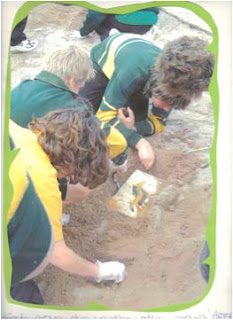Picture two groups of students, each with a box of assorted materials tasked with replicating artefacts from two diverse ancient societies. Picture one, a challenging student, bored with his piece of sandstone and soft rock, ‘messing about’ with the sticks and grinding stones together, adding water. He started painting on his sandstone. As an educator, how could you not be excited! Disengaged, bored student became engaged, positive contributor for the rest of the time I had that class. We went on to bury the artefacts at opposite ends of the long jump pit. Each group digging up the others artefacts, I could not believe how excited they were upon discovering each artefact!
When teaching a unit on the 1960s, I had the students painting their own ‘Further Bus’ after all, we needed transport to get to Woodstock at the end of the unit! As they painted the bus, discussions occurred between the students, sometimes heated exchanges! I listened, and realised not only had learning occurred but they were able to contextualise the knowledge to the point of being able to debate and discuss the issues we had covered.
History in my classroom involves a lot of hands on work, discussion and making phone calls to unsuspecting people who amazingly, agree to my odd requests. When planning a new topic sequence, I think what I would enjoy doing as I learn the skills and knowledge that are required by the curriculum. Where I can, I tailor activities to enable each student’s interests or strengths to emerge during the process.
Creating an engaging, interesting history lesson, while meeting curriculum requirements, is hard work. For me, allowing my passion for history to be seen by the students is very powerful, even if they do think you are a nerd. The reward is when you hear a student say with a note of surprise; “History IS really exciting miss! I love it”.










